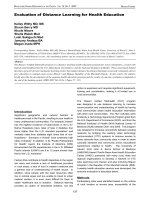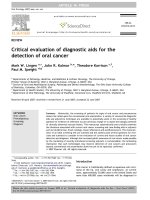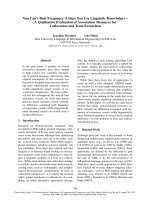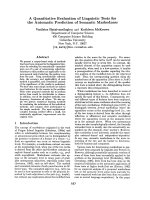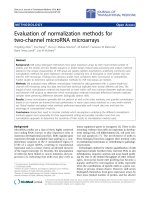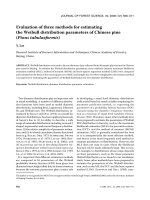Evaluation of Indian mustard for their potential nutritional and antinutritional factors
Bạn đang xem bản rút gọn của tài liệu. Xem và tải ngay bản đầy đủ của tài liệu tại đây (494.7 KB, 7 trang )
Int.J.Curr.Microbiol.App.Sci (2019) 8(5): 289-295
International Journal of Current Microbiology and Applied Sciences
ISSN: 2319-7706 Volume 8 Number 05 (2019)
Journal homepage:
Original Research Article
/>
Evaluation of Indian Mustard for their Potential Nutritional and
Antinutritional Factors
Anubhuti Sharma* and P.K. Rai
1
ICAR-DRMR, Bharatpur, Rajasthan, India
*Corresponding author
ABSTRACT
Keywords
Indian mustard,
Nutritional and
antinutritional
factors,
Glucosinolates
Article Info
Accepted:
04 April 2019
Available Online:
10 May 2019
100 genotypes from germplasm were taken to evaluate oil content, total
glucosinolate content, erucic acid, fibre content, phenol and sinigrin. The
assayed genotypes contained 38.38- 42.89 % oil, 38.97-113.01 µmole/g
glucosinolate, 18.67-47.05 % erucic acid, 1.03-1.93% Phenols, 7.8214.58% fibre and sinigrin 9.40-107.34% content using FT-NIR. The
objective of this study is to characterize the large population of genotypes
with advanced technique e.g. FT-NIR within short time period. Result
clearly showed that seeds of core set of Indian mustard having high
glucosinolates, grown at a field site revealed a wide variation in total
concentrations of seed oil, erucic acid, phenols and mainly sinigrin.
workers
for
various
nutritional
&
antinutritional factors (Anubhuti et al., 2017).
These quality characteristics are important as
these can further be used for breeding
programs. However, breeders need large
variability to initiate selection programs.
Therefore, study of genetic diversity of
nutritional & antinutritional factors in brown
mustard collection would help breeders in
genotypic screening and selection in order to
achieve high sinigrin level improvement.
Sinigrin, a major aliphatic glucosinolate, is
mainly responsible for acetylcholinesterase
(AChE) inhibitory activities of Brassicaceae
Introduction
A large variability in nutritional quality
parameters exists not only between different
oilseed crops, but also within the same
species. Nutritional quality of rapeseedmustard seed is determined by oil content and
its fatty acid constituents and various antinutritional factors including glucosinolates,
phytic acid, sinapine etc. These factors are
also very important as it can be used to
provide defense response in plants (Sharma et
al., 2016). Quality characteristics of rapeseedmustard oil have also been reported by earlier
289
Int.J.Curr.Microbiol.App.Sci (2019) 8(5): 289-295
family (Ivica, 2014; Sharma et al., 2016). For
this work few sensitive instruments can be
used e.g. HPLC, GC-MS, NIR, FT-NIR etc.
However Fourier transmission-Near Infrared
Reflectance Spectroscopy is a rapid analytical
technique results in many advantages, e.g.
short time of analysis, low cost/sample ratios
and no use of hazardous chemicals (Font et
al., 2005).
genotypes. Data was rechecked in laboratory
using spectrophotometric method. The dust
free intact seeds (about 2 g) of Brassica
juncea were packed in a standard ring cup and
then scanned for oil content, glucosinolates,
fibre content, phenols and erucic acid. The
samples were scanned thrice to minimize the
sampling error. However, sinigrin content was
estimated directly by HPLC (Agilent 1100
series HPLC instrument with 6460 triple quad
MS
detector)
through
outsourcing
(Directorate of Agricultural marketing, New
Delhi).
However, till date major work has been done
to decrease glucosinolates and erucic acid or
to raise seed oil content. Other studies used
molecular markers to structure genetic
diversity for crop improvement programms.
Nevertheless, these studies did not help
breeders in the selection of genotypes to
perform crosses to manage the glucosinolates/
sinigrin/erucic acid level in seed. However,
few studies which focused on glucosinolates
evaluation were done on local genotypes or
performed on green tissues or both.
The glass vials with seed samples were kept
into sample holder for the spectral acquisition
for FT-NIR measurement (Bruker Optics,
Ettlingen, Germany) which is equipped with
an integrative sphere, over the range 12,800–
3600 cm−1 (780–2780 nm) at 1 nm interval
(Bala and Singh, 2013). Spectral acquisition
was carried by OPUS spectroscopy software
(v. 6.0 Bruker Optics, Ettlingen, Germany).
Therefore, this study aims to characterize
biochemical traits e.g. nutritional &
antinutritional factors and their correlations in
the large number of brassica genotypes.
Statistical analysis
The statistical analyses were performed using
Statistical Analysis System (SAS) JMP
software version 9.0. The analysis of oil
content, glucosinolate, erucic acid, phenol,
fibre and sinigrin of each brassica genotype
was based on three replications and the results
are expressed as mean values ± standard error
(SE). For multi-factorial comparison,
principal component analysis (PCA) and two
way agglomerative hierarchical clustering
(AHC) were used to display the correlations
between the various parameters viz. oil
content, glucosinolate, erucic acid, phenol,
fibre and sinigrin of 100 brassica genotype.
Materials and Methods
Plant material
A core set of 100 genotypes of the brownseeded Indian mustard (Brassica juncea) with
different traits for agronomic and nutritional
characters were taken. Seeds of 100
genotypes were obtained from the germplasm
section, ICAR-DRMR, Bharatpur.
In seeds, oil content, glucosinolates, erucic
acid, fibre content and phenols have been
estimated by Fourier transmission-Near
Infrared Reflectance Spectroscopy (FT-NIR)
(Bruker Optics, Ettlingen, Germany), a fast,
reliable and rapid method which is generally
used for screening the large number of
Results and Discussion
Large genotypic variability was observed
within the studied collection for all measured
traits. The mean values for oil content were
290
Int.J.Curr.Microbiol.App.Sci (2019) 8(5): 289-295
found to vary from the minimum of 38.38 %
in FA-77 to the maximum of 42.89 % in FA63 with population mean of 41.01%. As
shown in Table 1 the higher oil content
(>42.00 %) were found in grains of FA-4,
FA-5, FA-12, FA-18, FA-25, FA-33, FA-49,
FA-50, FA-53, FA-58, FA-63, FA-70, FA-71,
FA-75, FA-88, FA-93 and FA-99 genotypes.
The mean values for erucic acid content were
found to vary from the minimum of 18.67 %
in inbred line FA-83 to the maximum of 47.05
% in FA-36 with population mean of 35.03%.
Lower erucic acid content (<20 %) were
found in the grains of FA-10, FA-62, FA-75
and FA-83 genotypes. However revalidations
of the results with other spectrophotometric
methods are under progress.
Lower phenol content (<1.3 %) were found in
the grains of FA-8, FA-15, FA-59, FA-81 and
FA-83 genotypes. The mean values for fiber
content were found to vary from the minimum
of 7.82 % to 14.58 µg/g. High fiber content
(>14%) were found in the grains of FA-52,
FA-65, FA-94, FA-95 and FA-98 genotypes.
The lower sinigrin content (>15 µmole/g)
were found in the grains of FA-37, FA-42,
FA-45, FA-51 and FA-98 genotypes.
However perusal of glucosinolate and sinigrin
data clearly indicates the absence of a
significant
relationship
between
total
glucosinolate and sinigrin content. This was
also reported by Merah (2015). Detailed
analysis of these glucosinolates showed large
genotypic differences for both sinigrin and
total glucosinolate levels in the collection.
PCA analysis clearly depicts the relationship
of sinigrin with total glucosinolates.
The mean values for total glucosinolate
content were found to vary from the minimum
of 38.97 µmole/g in inbred line FA-37 to the
maximum of 113.01 µmole/g in FA-33 with
population mean of 67.43 µmole/g. Lower
glucosinolate content (<40 µmole/g) were
found in the grains of FA-37, FA-62 and FA75 genotypes. Large genotypic variability was
observed within the studied collection for all
measured traits (Table 1). The observed
values for total glucosinolates were similar to
those observed by Lionneton et al., (2004)
within a mapping doubled haploid population.
The concentration range of glucosinolates
observed in our study was largely higher than
those reported in other studies for
glucosinolate content in mustard seeds
(Ogbonnaya et al., 2003). However, most of
those studies were focused on varieties
devoted to oil and seedmeal production and
with low glucosinolate contents (Bell et al.,
2015; Beniwal et al., 2015). Wide variation in
glucosinolate content among genotypes, also
suggest differences in their health promoting
properties
and
the
opportunity for
enhancement of their levels through genetic
manipulation (Kushad et al., 1999).
Principal Component Analysis (PCA) is a
useful statistical technique to reveal the
interrelationships between the different
variables and to determine the optimum
number of extracted principal components.
The first principal component (PC1) had the
highest Eigen value of 1.57 and accounted for
26.3 per cent of the total variation in the data
set, while the second principal component
(PC2) with Eigen value of 1.33 explained
22.1 per cent of the variation.
The projections of genotypes and traits are
shown in PC1 and PC2 biplot (Fig. 1). In
PCA, the length, direction and the angles
between the lines indicate correlation between
the variables or between variables and
principal component axes (e.g., α=00 and/or
1800 and r=1; α=900 and r=0). The longer the
line, the higher is the variance. The cosine of
the angle between the lines approximates the
correlation between the variables they
291
Int.J.Curr.Microbiol.App.Sci (2019) 8(5): 289-295
represent. The closer the angle is to 90 or 270
degrees, the smaller the correlation. An angle
of 0 or 180 degrees reflects a correlation of 1
or -1, respectively (Fig. 1). All parameters
occupied the right side of the biplot. Oil,
erucic and phenol were observed on the right
upper side of the biplot with high positive
loading for both PC1 and PC2, while fibre,
gls and sinigrin were grouped together on the
right lower side of the biplot with positive
loadings for PC1 and negative loadings for
PC2. Significant positive correlation was
observed between oil, erucic, phenol and sin.
Sinigrin and gls also showed significant
positive correlation (r=0.449) with each other.
Non significant negative correlation was
observed among oil, sinigrin and phenol.
Table.1 Correlation between 100 genotypes of core set
Fig.1 Biplot analysis of 100 genotypes
292
Int.J.Curr.Microbiol.App.Sci (2019) 8(5): 289-295
Fig.2 Dendrogram of the genotypes showing different groups of biochemical traits
293
Int.J.Curr.Microbiol.App.Sci (2019) 8(5): 289-295
Three groups of hundred core set genotypes
can be distinguished (Fig. 2). The first one is
composed of 36 genotypes containing low
sinigrin (less than 45 µmole/g of total GLS).
Thirty nine genotypes composed the second
group and are characterized by high level of
sinigrin. Twenty four other genotypes
constitute a third group with an intermediate
level of sinigrin ranged from 35 to 65% of
total GLS. Detailed analysis of these
glucosinolates showed large genotypic
differences for sinigrin levels in our
collection. As previously reported sinigrin
was consistently dominant over other
glucosinolates (Rangkadilok et al., 2002;
Merah, 2015). However few studies also
showed that heavy seeds are poorer in sinigrin
and tall plants are richer in sinigrin. These
interesting
correlations
need
further
investigations to study the sinigrin level with
vegetative growth in brassica.
References
Bell, L., Oruna-Concha, M. J., and Wagstaff,
C.
2015.
Identification
and
quantification of glucosinolate and
flavonol compounds in rocket salad
(Eruca sativa, Eruca vesicaria and
Diplotaxis tenuifolia) by LC–MS:
highlighting the potential for improving
nutritional value of rocket crops. Food
Chemistry. 172:852–861.
Beniwal, V., Aggarwal, H., Kumar, A., and
Chhokar, V. 2015. Lipid content and
fatty acid change in the developing
silique wall of mustard (Brassica
juncea
L.),
Biocatalysis
and
Agricultural Biotechnology. 4: 122–
125.
Font R, Del Rio-Celestino M, Cartea E, de
Haro-Bailon A, (2005). Quantification
of glucosinolates in leaves of leaf rape
(Brassica napus ssp. pabularia) by
near-infrared
spectroscopy,
Phytochemistry, 66: 175-185.
Ivica, B. 2014. Glucosinolates: Novel Sources
and Biological Potential. Austin J
Bioorg & Org Chem. (1): 4.
Kushad, M.M., Brown, A.F., Kurilich, A.C.,
Juvik, J.A., Klein, B.P., et al., 1999.
Variation of glucosinolates in vegetable
crops of Brassica oleracea. J Agric
Food Chem 47: 1541-1548.
Lionneton, E., Aubert, G., Ochatt, S., and
Merah, O. 2004. Genetic analysis of
agronomic and quality traits in mustard
(Brassica juncea). Theoretical and
Applied Genetics. 109 (4):792–799.
Manju Bala, Mhararaj Singh. 2013.
Nondestructive estimation of total
phenol and crude fibre content in intact
seeds of rapeseed mustard using FTNIR. Industrial Crops and Products, 42:
357-362.
Merah, O. 2015. Genetic Variability in
Glucosinolates in Seed of Brassica
juncea: Interest in Mustard Condiment.
In conclusion, the analytical analysis to
characterize biochemical traits mainly
aliphatic glucosinolate i.e. sinigrin with the
help of FT-NIR and HPLC confirms the large
genotypic variability for oil, glucosinolates,
erucic acid and sinigrin within the seeds of
Indian mustard collection from germplasm.
These results are of interest for breeders so
that they can combine both agronomic and
nutritional traits to achieve high sinigrin
content (approx 75-95 µmol.g-1) and high
seed yield.
In this study some genotypes (FA-3, FA-26,
FA-33, FA-47, FA-49) showed high levels of
sinigrin and could be used in breeding
programs for improvement of glucosinolates
mainly sinigrin level. Revalidations of the
results are in progress.
Acknowledgement
The author is grateful to ICAR-DRMR,
Bharatpur for financial & technical help
during experimentation.
294
Int.J.Curr.Microbiol.App.Sci (2019) 8(5): 289-295
Journal of Chemistry, Article ID
606142.
/>Ogbonnaya, F. C., Halloran, G., Pang, E., and
Gororo, N. 2003. Molecular analysis of
genetic diversity in Brassica juncea and
B. nigra germplasm accessions. In
Proceedings of the 11th International
Rapeseed Congress, pp. 489–491,
Copenhagen, Denmark, July.
Rangkadilok, N., Nicolas, M. E., Bennett, R.
N., Premier, R. R., Eagling, D. R., and
Taylor, P. W. J. 2002. Developmental
changes of sinigrin and glucoraphanin
in three Brassica species (Brassica
nigra, Brassica juncea and Brassica
oleracea
var.
italica).
Scientia
Horticulturae. 96: 11–26.
Sharma, A., Kumar, A., Meena, H. S., and
Singh, D. 2017. Chromatographic
determination of phenolics in Brassica.
Asian Journal of Chemistry. 29 (2):
296-300.
Sharma, A., Sharma, A.K., Yadav, P., and
Singh, D. 2016. Isothiocyanates in
Brassica: A potential anticancer agent.
Asian pacific Journal of cancer
prevention. 17 (9): 4507-4510.
How to cite this article:
Anubhuti Sharma and Rai, P.K. 2019. Evaluation of Indian Mustard for their Potential
Nutritional and Antinutritional Factors. Int.J.Curr.Microbiol.App.Sci. 8(05): 289-295.
doi: />
295

